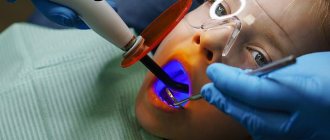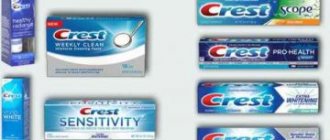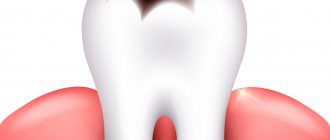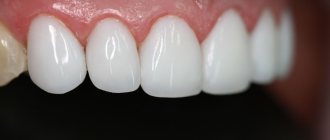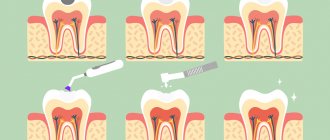Author of the article:
Soldatova Lyudmila Nikolaevna
Candidate of Medical Sciences, Professor of the Department of Clinical Dentistry of the St. Petersburg Medical and Social Institute, Chief Physician of the Alfa-Dent Dental Clinic, St. Petersburg
Modern dentistry has come a long way, and today treating even the most complex cases of caries often does not pose a big problem for doctors. However, despite advances in knowledge and equipment, caries and its treatment are still associated with significant discomfort and the risk of developing dangerous complications. That is why the most effective means of combating this disease remains the prevention of caries.
To do this, you should choose high-quality cleaning products. Asepta offers a line of toothpastes that meet all the requirements for impeccable hygiene. They contain a sufficient amount of minerals that compensate for their deficiency in the enamel; a natural enzyme that effectively breaks down plaque; gentle abrasives that gently whiten teeth.
How to prevent caries and can it be stopped? Unfortunately, the answer may be different in each individual case. The development of caries is closely related not only to personal hygiene, but also to the genetically determined characteristics of the body. However, we can say with confidence that modern methods of caries prevention are quite effective and in many cases make it possible not only to prevent the development or stop the developing carious process, but also to restore the affected tissue.
Mechanism of caries development
Caries is a dental pathology that destroys the structure of the tooth. It develops when a large number of cariogenic bacteria create a lot of organic acid in the mouth. It penetrates the structure of enamel and dentin, softens them, which leads to carious lesions. The more bacteria and the acid they produce, the more active dental caries develops.
In this article
- Mechanism of caries development
- Why is it important to stop tooth decay?
- Can dental caries be prevented?
- Fissure sealing is a way to prevent or slow down caries in a child
- How to stop caries?
- How can you stop caries at the spot stage?
- Features of caries in elderly patients: how to slow it down
- Conclusion
This pathology affects people of different ages. In recent years, experts have noted a trend towards an increase in morbidity among children. According to statistics, by the age of seven, approximately 85% of children’s teeth are affected by caries, and among the adult population this dental disease ranks first in prevalence.
Types of prevention
Prevention of dental diseases is one of the branches of dentistry. There are two categories of preventive measures:
- endogenous - allow you to improve the condition of the body, saturate dental tissues with useful substances using food or drugs (medicinal and non-medicinal);
- exogenous - are hygienic, medical procedures performed in the oral cavity.
Prevention measures are standard, but there are some nuances that are taken into account when selecting preventive measures for children and adults.
Why is it important to stop tooth decay?
Any disease is easier to prevent than to treat. And dental caries is no exception. There are many reasons why it is important to stop the progression of tooth decay as early as possible.
- It is easier to treat teeth at an early stage.
The peculiarity of caries is that it develops gradually and relatively slowly. At an early stage, it looks like a small chalky stain on the enamel and is very easy to treat. The damaged area of the tooth is covered with special gels and solutions that restore the mineral composition of the enamel, or treated with an infiltration composition - it seals the enamel pores. The main thing is that caries can be treated at an early stage without preparing the carious cavity. It is quick, painless, simple and allows you to preserve the integrity of the tooth.
- Treatment in later stages is painful.
If the further spread of caries is not stopped, it will penetrate into the deeper tissues of the tooth, which will lead to the formation of a cavity and sometimes damage to the pulp. Such caries is treated with drilling, cleaning, filling - such procedures are unpleasant and painful, and therefore require anesthesia.
- With untreated caries, there is a risk of severe destruction or complete loss of the tooth.
In such cases, crowns or implants will have to be installed, which involves large financial costs. In addition, an artificial tooth does not have the same strength as a real one, and its useful life is limited.
- Carious teeth are a source of infection.
Teeth affected by caries are a source of chronic infection in the body. The deeper the process spreads, the greater the risk of infection of other organs and tissues.
- Bad teeth lead to digestive problems.
Teeth support the chewing process. With caries, they become less durable, cease to cope well with the chewing function, which is fraught with digestive disorders and can lead to gastrointestinal diseases.
- Aesthetics are compromised.
Teeth are not only health, but also beauty. Teeth affected by caries darken, holes form in them, the smile loses its attractiveness, which is reflected in a person’s appearance.
- Complex caries is more expensive to treat.
Dental treatment is not cheap. Moreover, the more serious the problem, the more expensive it will cost. Therefore, stopping caries at an early stage is much more profitable from a financial point of view.
The need to solve smaller problems
Major dental problems, such as tooth decay, can be prevented if smaller problems are addressed in a timely manner. For example, if a person notices that his teeth have turned yellow, become more sensitive, or have stones on them, then he should immediately run to the dentist. Solving this kind of problem will allow you to avoid encountering more serious consequences - caries.
To avoid caries, a person needs to:
- Periodically have your teeth professionally cleaned in a dental office; contact your dentist to determine the causes of tooth sensitivity and the possibility of solving them competently; remove tartar as soon as it appears so that the teeth do not become weaker and caries does not occur.
- If you solve minimal problems with your teeth in a timely manner, then it will not come to the development of caries. The main thing is to regularly visit a professional dentist and not let the problem worsen.
Can dental caries be prevented?
The fact that about 90% of the world's inhabitants have caries does not mean that this pathology cannot be prevented. An integrated approach to preventive measures will significantly reduce the risk of dental caries.
- Regular teeth cleaning.
Oral hygiene comes first in importance in the development of caries. Cariogenic bacteria live in dental plaque and feed on food debris. If you brush your teeth, as doctors recommend, twice a day for at least 2-3 minutes, following the basic rules of brushing, you can protect your teeth from caries.
- Use of additional hygiene products.
Using dental floss and irrigator, along with a brush and paste, helps improve the quality of oral care and reduce the risk of dental caries. The floss is needed to clear the interdental spaces of partially stuck food. This helps prevent contact caries developing on the lateral surfaces of the teeth. Using a powerful water jet, the irrigator cleans not only the interdental spaces, but also periodontal pockets, the space under crowns, dentures and other hard-to-reach areas.
- Strengthening the immune system.
A weakened immune system cannot resist the destructive effects of bacteria. Therefore, in order to prevent the development of dental caries, it is important to strengthen the immune system. An integrated approach may include hardening, proper nutrition, a healthy lifestyle, and taking vitamin supplements as prescribed by a doctor.
- A balanced diet rich in vitamins and microelements.
To prevent or slow down the development of caries, it is necessary to adjust nutrition in several areas. Reduce your consumption of simple carbohydrates - sugary foods and drinks, baked goods, fast food. Reduce the number of snacks and stop eating sweets at night. Make sure your diet includes plenty of foods rich in phosphorus, calcium, fluoride, and vitamin D. There should also be plenty of solid vegetables and fruits, which naturally cleanse your teeth of food debris and plaque.
Expert advice and recommendations
- To more effectively remove sticky and sugary food residues, use fluoride rinses.
- It is worth limiting the consumption of foods high in sugar. Candies and donuts can be replaced with fruit.
- To prevent caries, it is important that teeth brushing occurs immediately after eating.
- It is extremely undesirable to eat foods that contrast in temperature, as this negatively affects the condition of the enamel and contributes to the occurrence of microcracks.
Fissure sealing is a way to prevent or slow down caries in a child
Caries in a child can be stopped by fissure sealing. Fissures are the natural grooves and grooves on the chewing surface of the teeth. The anatomical features of their structure are such that food debris is easily retained in the fissures, and the process of enamel mineralization is slower than in other areas of the teeth.
To prevent dental caries (most often in children, but the method is also applicable for adults), fissures are sealed. The essence of the method is that natural grooves are covered with special dental sealants containing calcium and fluoride. Sealants seal the tooth, preventing the impact of cariogenic factors on it, and the mineral components included in the composition nourish the dental tissues.
The main indication for sealing is deep fissures that are difficult to clean during daily oral hygiene.
It is optimal for a child to seal the grooves on the teeth six months after teething. At about 6-8 years old, the child’s permanent teeth begin to be sealed - first the first molars, closer to 10 years - the premolars, and by the age of 12-13 - the second molars.
Sealing is not carried out if caries has already formed in the fissures - like a stain or a cavity in the tooth.
The sealing procedure can be invasive or non-invasive; the technology is selected by the doctor individually for each patient. If the fissure is clearly visible, it is sealed using a non-invasive method: the tooth is cleaned of plaque, treated with a special gel that ensures reliable fixation of the filling, sealant is applied and illuminated with a lamp. For narrow and deep fissures, the bottom and walls of which are difficult to see to ensure the absence of caries, the dentist chooses an invasive sealing method.
After cleaning the tooth, the fissures are opened with a drill and their condition is assessed. In the absence of carious lesions, further sealing is carried out similarly to the non-invasive method. Fissure sealing is one of the most effective ways to prevent caries in chewing teeth.
What else do you need to know?
- To maintain healthy teeth and gums, it is important to use a brush of medium hardness; the bristles should not scratch the enamel and mucous membrane or cause discomfort. It must be changed at least every 2 months, since pathogenic microorganisms accumulate on the bristles. You also need to replace the brush if it has lost its original shape.
- When using a toothpaste containing fluoride, you must not only brush your teeth for 2-3 minutes, but also not rinse your mouth for the same amount of time. During this period, the active components will penetrate the enamel, which will increase the effectiveness of remineralization.
- When choosing a toothpaste with fluoride, it is better to give preference to more expensive options, since they contain sodium aminofluorides. These substances are more effective than sodium monofluorophosphate, which is present in budget toothpastes. Saving in this case is impractical.
- Do not neglect mouth rinses. They contain sodium fluorides and aminofluorides, antiseptic and antibacterial components that prevent plaque formation and inhibit the growth and reproduction of cariogenic microbes. But you should also not overuse mouthwashes, since antiseptics can disrupt the composition of the microflora of the oral cavity, resulting in an unpleasant odor.
Remember that caries prevention will be effective only with an integrated approach and regular visits to the dentist. It is better to make sure once again that your teeth are healthy than to treat the consequences of a negligent attitude towards yourself.
| Author of the article: | Gasparyan Eliza Arturovna |
| Speciality: | Dentist-therapist, dentist-endodontist |
| Experience: | 10 years |
Make an appointment
How can you stop caries at the spot stage?
The first stage, in which only a small light spot forms on the enamel, is the most favorable from the point of view of treatment prognosis. At an early stage of caries, it is possible to cure it without painkilling injections, preparation of the carious cavity, or filling.
How to stop caries is decided by the dentist in each specific case, but today there are several possible non-invasive methods.
- Remineralization of enamel.
Caries begins when tooth enamel loses minerals, loses its strength and cannot effectively protect the deep tissues of the tooth from the acid produced by bacteria. Remineralizing therapy is aimed at restoring the balanced composition of the enamel, strengthening its structure, and returning its strength and protective characteristics. The essence of the method is that the dentist alternately applies compositions containing phosphorus, calcium and other useful substances to the cleaned tooth surface. Another way is to attach special trays with remineralizing gel to the teeth.
- Fluoridation.
Using this method, you can increase the strength of enamel, its resistance to acid, eliminate microdamage, and reduce the pain reaction to cold/hot. Saturation of dental tissues with fluoride ions helps to achieve this effect. A simple or deep fluoridation procedure is possible. In the first case, the dentist uses fluoride varnishes or fluoride gels. They are applied to the teeth using trays or cover the surface of the enamel with a brush. In deep fluoridation, compounds are used to seal tooth enamel. The teeth are first cleaned, dried, isolated from saliva, deep fluoride is applied to them, dried again, and then treated with copper-calcium hydroxide. With this method, a fluoride-containing substance penetrates deeply into the pores of tooth enamel and helps preserve calcium.
- Infiltration method.
Another method will stop the development of caries at the spot stage without drilling and filling, and will prevent the formation of a carious cavity. First, the dentist treats the carious stain with a special etching composition; the next step is to apply a liquid composition to the cleaned, washed and dried surface to seal the pores of the tooth. The infiltration method helps stop the spread of the carious process, since the acid produced by bacteria cannot penetrate the sealed pores of the enamel and continue the destructive process. The method is completely safe, painless and suitable even for children over three years old. This treatment is usually not performed on a younger child, because during the procedure you need to sit still for about 20 minutes, which is not possible for small children.
In addition to the listed methods, ozone therapy and laser therapy are used today, which also help stop the carious process without tooth preparation. If a hole has already formed, then the only way to stop caries is surgical treatment. Using a drill, the doctor removes the affected tissue, prepares the cavity for filling and installs the filling there layer by layer, returning the tooth to its natural anatomical shape.
Professional hygiene
Modern methods of preventing dental caries involve in-office hygienic cleaning twice a year. Professional hygiene is aimed at removing bacterial plaque and mineralized formations (plaques, stones) from the supragingival and subgingival parts of the tooth. Hygienic cleaning includes the following steps:
- Removal of hard and soft deposits using the AIR-FLOW method or ultrasonic scaler.
- Polishing the surface of the teeth with an abrasive paste.
- Protection of enamel with fluorine varnish.
Hygienic procedures are painless and carried out quickly. Another plus is that the dentist gets the opportunity to accurately assess the condition of the oral cavity and detect pathology at the initial stage. Each stage can be carried out as an independent procedure. But it is a complete hygiene complex that will ensure effective prevention of diseases of the teeth and gums.
Features of caries in elderly patients: how to slow it down
Elderly people are considered to be over 60 years of age. Caries in the elderly develops under the influence of the same cariogenic factors as in younger people, but there are some peculiarities.
A study conducted in a Swiss clinic showed that in patients aged 50-94 years, a quarter of the remaining teeth were affected by caries.
One of the characteristic features of caries in the elderly is its localization in the neck of the tooth. Often in older people, carious lesions do not spread deep into, but along the surface of the tooth enamel. Many people wear dentures, and the teeth in contact with them are often affected by caries. A large percentage of defects are recurrent and chronic caries.
As you age, the risk of tooth root caries increases, which some doctors call the main problem in treating the teeth of older people.
Effective measures to prevent caries in the elderly are:
- professional oral hygiene twice a year;
- brushing your teeth twice a day using a toothbrush, toothpaste and floss;
- use of saliva thinners;
- deep fluoridation of dental tissues.
This set of preventive measures helps reduce the risk of developing caries in the elderly by more than half.
Clinical researches
ASEPTA toothpastes are clinically proven effective. For example, clinical studies have proven that regular use of professional toothpaste ASEPTA REMINERALIZATION improved the condition of the enamel by 64% and reduced tooth sensitivity by 66% after just 4 weeks.
In addition, clinical studies have proven that regular use of preventive toothpaste ASEPTA ACTIVE for a month can reduce bleeding gums by 60%, improve the overall condition of the oral cavity by 44% and reduce inflammation by 33%.
Sources:
- Report on determining/confirming the preventive properties of toothpaste “ASEPTA PLUS” GENTLE WHITENING” Author: doctor-researcher A.A. Leontyev, head Department of Preventive Dentistry, Doctor of Medical Sciences, Professor S.B. Ulitovsky First St. Petersburg State Medical University named after. acad. I.P. Pavlova, Department of Preventive Dentistry
- Clinical and laboratory assessment of the influence of domestic therapeutic and prophylactic toothpaste based on plant extracts on the condition of the oral cavity in patients with simple marginal gingivitis. Doctor of Medical Sciences, Professor Elovikova T.M.1, Candidate of Chemical Sciences, Associate Professor Ermishina E.Yu. 2, Doctor of Technical Sciences Associate Professor Belokonova N.A. 2 Department of Therapeutic Dentistry USMU1, Department of General Chemistry USMU2
- Report on the determination/confirmation of the preventive properties of personal oral hygiene products “ASEPTA PLUS” Remineralization doctor-researcher A.A. Leontyev, head Department of Preventive Dentistry, Doctor of Medical Sciences, Professor S.B. Ulitovsky First St. Petersburg State Medical University named after. acad. I.P. Pavlova, Department of Preventive Dentistry
- Clinical studies of antisensitive toothpaste “Asepta Sensitive” (A.A. Leontyev, O.V. Kalinina, S.B. Ulitovsky) A.A. LEONTIEV, dentist O.V. KALININA, dentist S.B. ULITOVSKY, Doctor of Medical Sciences, Prof. Department of Therapeutic Dentistry, St. Petersburg State Medical University named after. acad. I.P. Pavlova
- The role of anti-inflammatory rinse in the treatment of periodontal diseases (L.Yu. Orekhova, A.A. Leontyev, S.B. Ulitovsky) L.Yu. OREKHOVA, Doctor of Medical Sciences, Prof., Head of Department; A.A. LEONTIEV, dentist; S.B. ULITOVSKY, Doctor of Medical Sciences, Prof. Department of Therapeutic Dentistry of St. Petersburg State Medical University named after. acad. I. P. Pavlova
- Report on determining/confirming the preventive properties of toothpaste “ASEPTA PLUS” COFFEE and TOBACCO Author: doctor-researcher A.A. Leontyev, head Department of Preventive Dentistry, Doctor of Medical Sciences, Professor S.B. Ulitovsky. First St. Petersburg State Medical University named after. acad. I.P. Pavlova, Department of Preventive Dentistry
- Report on determining/confirming the preventive properties of commercially produced personal oral hygiene products: Asepta toothpaste used in combination with Asepta mouthwash and Asepta gum balm Head. Department of PFS Doctor of Medical Sciences Professor S.B. Ulitovsky St. Petersburg State Medical University named after Academician I.P. Pavlova. Faculty of Dentistry. Department of Preventive Dentistry.
Which toothbrush is better
Electric toothbrushes are many times more expensive than regular ones. But it does seem to make sense in terms of plaque and gingivitis control.
Researchers compared the teeth of adults and children who used electric and regular toothbrushes. Within a month, it turned out that among representatives of the first group, plaque formation decreased by 11%, and after three months - by 21%. After a month of using electric toothbrushes, the incidence of gingivitis decreased by 6%, and after 3 months - by 11%.
Models with a rotating head cope best with plaque.
